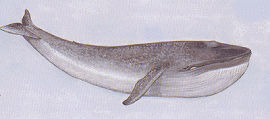Overview
 Order: Artiodactyla
Order: Artiodactyla
Family: Balaenopteridae
Species: Balaenoptera musculus
IUCN Red List status: Endangered
Population trend: increasing
Order: Cetacea
Family: Balaenopteridae
Distribution: Scattered areas in all major oceans but mainly in Arctic and Antarctic waters.
Size: Length: 31m (104ft) Weight: 125+tonnes
Life Span: 80 years
Gestation period: 11 months
Food: Small crustaceans
Feeding
Although blue whales should be capable of roaming the oceans freely, they are tied to certain areas. This is because there are only a few places in the world, mainly the Arctic and Antarctic oceans, where there is enough plankton to sustain them. Icy water has more oxygen and carbon dioxide than warm water which makes it rich in marine life. There is up to twenty times more plankton in the Arctic and Antarctic than in the clear blue, warmer waters of the tropics. When the polar oceans freeze up during the winter, the whales migrate to the tropics where they live mainly off their thick layer of blubber.
Prey is mainly caught by diving, up to depths of 500m. The whale can stay submerged for up to two hours, then it rushes up at the clouds of plankton with open mouth. The blue whale does not have teeth; instead it has a row of plates in its mouth, known as baleen, measuring 100 cm long by 55 cm wide. There is a ‘moustache’ of long bristles on the end of each plate to hold the tiny prey; after forcing the water out of its mouth, the whale licks the krill off with its fleshy tongue. Up to 5 tonnes of water and krill (a type of plankton) can enter this sieve with each mouthful. An adult blue water will consume about 2,032 kg (2 tonnes) of krill each day during the summer months when it is roaming the polar waters.
Breeding
Blue whales mate in the warm waters of the tropics, and this is where the calves are born. At birth the baby may be up to 8.6m in length and weigh about 7,000 kg. After that, it increases its weight by about 90.7 kg a each day. In fact, the blue whale, from the time of conception until twelve months old, can claim the most rapid growth rate of any plant or animal species in the world.
In Danger
In recent decades the huge size of the blue whale has made it a prime target for the whaling industry. Antarctic whalers slaughtered 30,000 during the season of 1930-1931. The body was reduced into oil for use in food manufacture, and the baleen used for ‘whalebone’ (ladies’ corsets once contained this).
Since 1986 commercial whaling has largely ceased and the whales have shown some signs of breeding success. Although, according to the WWF, there are currently only 10,000 to 25,000 Blue Whales.
Credits
Image: Blue Whale by GrrlScientist
Information sourced from:
The IUCN Red List of Threatened Species (2015), Balaenoptera musculus [online],
Available from: http://www.iucnredlist.org/details/2477/0 [accessed 22/08/2015].
World Wildlife Fund (2015), Blue Whale [online], Available from: http://wwf.panda.org/what_we_do/about/blue_whale/
[accessed 22/08/2015].
Enormous Size
The blue whale is not only the largest living animal but probably the largest creature the world has ever known. One of the greatest recorded lengths for a blue whale is 33.58m (110ft, 2.5ins), but it may be unlikely that any of these huge specimens survive today.
Back in 1947 a female blue whale was dismembered and weighed aboard a factory ship ‘Hashidate Muru’ of the Japanese Whaling Fleet and the statistics recorded. The whale measured 27.12m (89ft) and weighted 136,353kg (134.2 tonnes) when in one piece. This in itself is quite an awe-inspiring size, but some of the other statistics become almost breathtaking. These are just a few of the items recorded that day.
Blood 8,128 kg (8 tonnes)
Skeleton 18,288 kg (18tonnes)
Heart 457 kg (1,300lbs)
Lungs 1,270 kg (1 tonne)
Tongue 3,048 kg (3 tonnes)
Blubber 19,812 kg (19 tonnes)
Skull 4,572 kg (4 tonnes)
Meat 60,962 kg (60 tonnes)
Jawbone 1,524 kg (1.5 tonnes)
Body Girth 13.35m (43’ 6”)
Jawbone length 6.96m (22’ 10”)
 Order: Artiodactyla
Order: Artiodactyla
